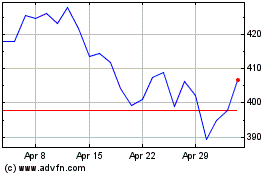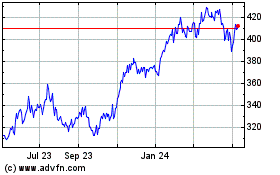By Angus Loten
Microsoft Corp. is leveraging a strong position in cloud
computing and enterprise software to drive growth for Teams, its
two-year-old enterprise collaboration tool, IT industry analysts
and researchers say.
The software giant Tuesday said more than 500,000 organizations
are using the tool for workplace chat, messaging and meetings,
including 91 Fortune 100 firms, and at least one Nascar racing
team.
Matthew Cochran, manager of IT at racing team Hendricks
Motorsports, said Teams became an essential communications tool at
the start of the 2018 season, when racing authorities limited the
number of crew members on the racing track to a dozen.
"We need to relay strategic information to the crew chief in the
box and the pit crew, so that they can make appropriate changes,"
Mr. Cochran said, adding that a lot of race information is
processed in the office, "where it's not as loud as on the track."
This includes everything from monitoring fuel, to tire wear and the
optimal position for the car on turns and straightaways, he
said.
"Teams allowed us to centralize messaging and use file-sharing
and other tools, all in one place," Mr. Cochran said.
Microsoft said of its current users, 150 organizations have at
least 10,000 active daily users. The company said it also has
completed its own internal migration, shifting 180,000 employees
from Skype for Business to Teams, as part of a move to replace
Skype over time.
To mark the two-year milestone, Microsoft this week rolled out a
number of new features for Teams, including customized backgrounds
for videoconferencing, live captions for meetings and a broadcast
feature for up to 10,000 viewers.
Larry Cannell, research director for collaboration and content
strategies at Gartner Inc., described Microsoft's strength in the
cloud as "an enabler" for Teams, but said its position on the
desktop plays a large role.
"CIOs of companies that have already purchased Office 365 and
finished migrating their email services are especially interested
in getting more out of their licenses" with Teams, Mr. Cannell
said.
Lori Wright, general manager of workplace collaboration at
Microsoft, said the tool's integration in Office 365 is a big
advantage, but a broader change in workplace culture also has been
a key driver of growth.
"Gone are the days of cubicles and silos," Ms. Wright told CIO
Journal. "Workplaces are moving from rigid hierarchical structures
to more inclusive models built around teamwork and shared
success."
The global market for enterprise collaboration is estimated to
have reached $2.4 billion last year, up 11.8% from 2017, and is
expected to hit $3.2 billion by 2021, according to International
Data Corp.
"The market is accelerating faster than even the most optimistic
forecasts," said Wayne Kurtzman, an IDC research director for
social and collaboration.
Much of that growth is driven by the consumerization of
technology, he added, which is prompting workers to expect the same
capabilities around the office that they now have sharing photos
and videos with friends, making restaurant and hotel reservations,
or buying services and products with their personal mobile
devices.
"The collaboration market is new enough that there is room for
several players in the years ahead," Mr. Kurtzman said.
Slack Technologies Inc., launched in 2013, said it has 10
million daily active users, including 65 Fortune 100 firms and
85,000 paying customers -- up 50% in the past year alone. Beyond
meetings and messaging, Slack in recent years has positioned itself
as a hub of workplace activity, offering more than 1,500 apps in
its directory, according to the company.
Last month, Slack announced plans to go public in a direct
listing on the stock market, with a likely valuation well above $7
billion. Slack declined to comment.
Facebook Inc.'s Workplace, another rival in the enterprise
collaboration space launched in October 2016, today has two million
paid users, including more than 150 companies with over 10,000
users each, the company said. It began charging users in October
2017.
"Real change and collaboration occurs when companies turn into
communities, and this is strongest when everyone from front-line
workers to the C-suite are connected," said Julien Codorniou, vice
president of Workplace by Facebook.
Write to Angus Loten at angus.loten@wsj.com
(END) Dow Jones Newswires
March 20, 2019 05:44 ET (09:44 GMT)
Copyright (c) 2019 Dow Jones & Company, Inc.
Microsoft (NASDAQ:MSFT)
Historical Stock Chart
From Mar 2024 to Apr 2024

Microsoft (NASDAQ:MSFT)
Historical Stock Chart
From Apr 2023 to Apr 2024
